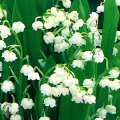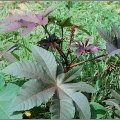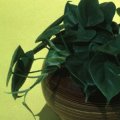Poisonous Plants: Common Indoor/Outdoor Plants that Most People Don't Know are Poisonous
by www.SixWise.com
Some of the most poisonous substances are those that are literally
right under our noses -- plants in our homes and gardens.
Most at risk are children -- who will taste plant leaves,
berries and flowers out of curiosity -- and pets.
Nearly 7 percent of poisonings in children under 6 are caused
by poisonous plants, according to the National Capitol Poison
Center, but adults, too, may unintentionally ingest a toxic
plant.
Below is a list of some of the most common plants you may
find in your home (though the list is NOT comprehensive) or
yard. If you identify a poison plant in your home, keep it
safely out of reach of children and pets. In your yard, always
be sure children and pets are supervised.
And, always teach young children that they should never taste
any plant, including berries and mushrooms, that they find.
 1.
Daffodil (Narcissus)
1.
Daffodil (Narcissus)
Daffodils contain poisonous alkaloids called narcitine
and narcicysteine.
Poisonous Parts: All, especially bulbs
Symptoms: Abdominal pains, vomiting, nausea, lightheadedness,
shivering, possibly diarrhea
Location: Daffodils are typically an outdoor plant, but
may be kept indoors during the winter. Cut daffodils are
a common ornamental flower for indoor arrangements.
 2.
Foxglove (Digitalis purpurea)
2.
Foxglove (Digitalis purpurea)
Foxglove contains digitoxin -- one of several cardiac
glycosides in the plant -- which is extremely toxic.
Poisonous Parts: All, including leaves, seeds
Symptoms: Major disturbances to heartbeat and pulse, abdominal
pains, diarrhea, nausea
Location: Outdoors
 3.
Iris (Iris)
3.
Iris (Iris)
Irises contain the potentially toxic compounds irisin,
iridin, or irisine.
Poisonous Parts: Bulb, leaves, stem
Symptoms: Nausea, vomiting, abdominal pain, diarrhea, fever,
skin irritation
Location: Can be a houseplant or an outdoor plant
 4.
Jerusalem Cherry (Solanum pseudocapsicum)
4.
Jerusalem Cherry (Solanum pseudocapsicum)
The toxic components in Jerusalem cherry are solanine
and other solanidine alkaloids.
Poisonous Parts: Leaves, unripe fruit
Symptoms: Abdominal pain, gastroenteritis, vomiting, headache,
lowered temperature, dilated pupils, diarrhea, circulatory
and respiratory depression, loss of sensation -- may be
fatal
Location: Outdoors
 5.
Lily of the Valley (Convdleria majalis)
5.
Lily of the Valley (Convdleria majalis)
Lily of the Valley contains about 20 poisonous glycosides,
including convalatoxin, convalarin, convalamarin, and saponins.
Poisonous Parts: All
Symptoms: Strong headache, nausea, vomiting, slow pulse,
excessive urination
Location: Outdoors
 6.
Morning Glory (Ipomoea)
6.
Morning Glory (Ipomoea)
Morning Glory contains toxic indole alkaloids.
Poisonous Parts: Seeds or skin contact with sap
Symptoms: Hallucinations, dilated pupils, nausea, vomiting,
diarrhea, drowsiness, numbness of extremities, headache
and muscle tightness.
Location: Houseplant or outdoors
 7.
Oleander (Nerium oleander)
7.
Oleander (Nerium oleander)
The toxic compound in oleander is called glycoside oleandrin.
Poisonous Parts: Stems, flowers, leaves
Symptoms: Nausea, vomiting, accelerated or retarded heartbeat,
and cardiac arrest
Location: Outdoors
 8.
Castor Bean (Ricinis communis)
8.
Castor Bean (Ricinis communis)
The Castor Bean contains the alkaloid ricinin and the
toxalbumin ricin, both of which are extremely toxic.
Poisonous Parts: All, especially the beans
Symptoms: Nausea, vomiting, stomachache, bloody diarrhea,
headache, cold sweat, sleepiness, disorientation, fever,
shortage of breath, seizures, and even death.
Location: Outdoors
 9.
Philodendron (Philodendron)
9.
Philodendron (Philodendron)
Philodendron contains poisonous calcium oxalate.
Poisonous Parts: All
Symptoms: Burning and swelling of the lips, tongue, and
throat, difficulty speaking, nausea, vomiting, diarrhea,
skin irritation
Location: Houseplant
 10.
Holly (Ilix)
10.
Holly (Ilix)
Holly contains several components that can be toxic, including
illicin, triterpenoids, and possibly saponic glycosides.
Poisonous Parts: Leaves and berries
Symptoms: Nausea, vomiting, diarrhea
Location: Outdoors
Recommended Reading
Flower
Power: What Each of the 20 Most Popular Flowers Symbolize
& Other Interesting Facts
The
Health Benefits of House Plants, Including the Top Nine Healthiest
Plants!
Sources
National
Capitol Poison Center
North
Carolina State Consumer Horticulture
ThinkQuest:
Poisonous Plants and Animals